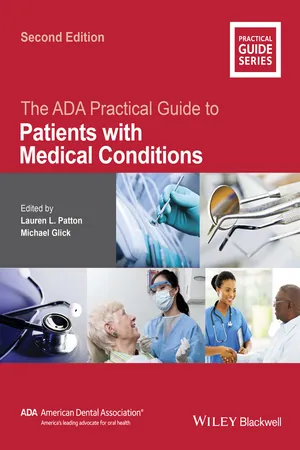
The ADA Practical Guide to Patients with Medical Conditions
- English
- ePUB (mobile friendly)
- Available on iOS & Android
The ADA Practical Guide to Patients with Medical Conditions
About This Book
With new medications, medical therapies, and increasing numbers of older and medically complex patients seeking dental care, all dentists, hygienists, and students must understand the intersection of common diseases, medical management, and dental management to coordinate and deliver safe care. This new second edition updates all of the protocols and guidelines for treatment and medications and adds more information to aid with patient medical assessments, and clearly organizes individual conditions under three headings: background, medical management, and dental management. Written by more than 25 expert academics and clinicians, this evidence-based guide takes a patient-focused approach to help you deliver safe, coordinated oral health care for patients with medical conditions. Other sections contain disease descriptions, pathogenesis, coordination of care between the dentist and physician, and key questions to ask the patient and physician.
Frequently asked questions
Information
1
Medical History, Physical Evaluation, and Risk Assessment
Abbreviations used in this chapter
| ADA | American Dental Association |
| ASA | American Society of Anesthesiologists |
| GERD | gastroesophageal reflux disease |
| PS | physical status |
I. Background
Four key risks of dental care
- Impaired hemostasis
- Susceptibility to infections
- Drug actions/interactions
- Patient’s ability to tolerate dental care
II. Medical History
- demographic information;
- screening questions for active tuberculosis;
- dental information;
- medical information, including physician contact information;
- hospitalizations, illnesses, and surgeri...
Table of contents
- Cover
- Titlepage
- Copyright
- Accessing Dr. Glick's Medical Support Website
- Contributors
- Preface
- Acknowledgments
- Chapter 1: Medical History, Physical Evaluation, and Risk Assessment
- Chapter 2: Cardiovascular Diseases
- Chapter 3: Pulmonary Disease
- Chapter 4: Endocrine and Metabolic Disorders
- Chapter 5: Kidney Disease
- Chapter 6: Hepatic Disease
- Chapter 7: Gastrointestinal Disease
- Chapter 8: Hematological Disease
- Chapter 9: Bleeding Disorders
- Chapter 10: Autoimmune and Connective Tissue Diseases
- Chapter 11: Human Immunodeficiency Virus/Acquired Immune Deficiency Syndrome and Related Conditions
- Chapter 12: Immunological and Mucocutaneous Disease
- Chapter 13: Head and Neck Cancer
- Chapter 14: Neurological Disorders
- Chapter 15: Neurodevelopmental and Psychiatric Disorders
- Chapter 16: Substance Use Disorders
- Chapter 17: Developmental Defects of the Craniofacial Complex and Orthopedic Disorders
- Chapter 18: Geriatric Health and Functional Issues
- Chapter 19: Women’s Health
- Chapter 20: Medical Emergencies
- Chapter 21: Medical Screening/Assessment in the Dental Office
- Appendix: List of Common Drugs
- Index
- EULA